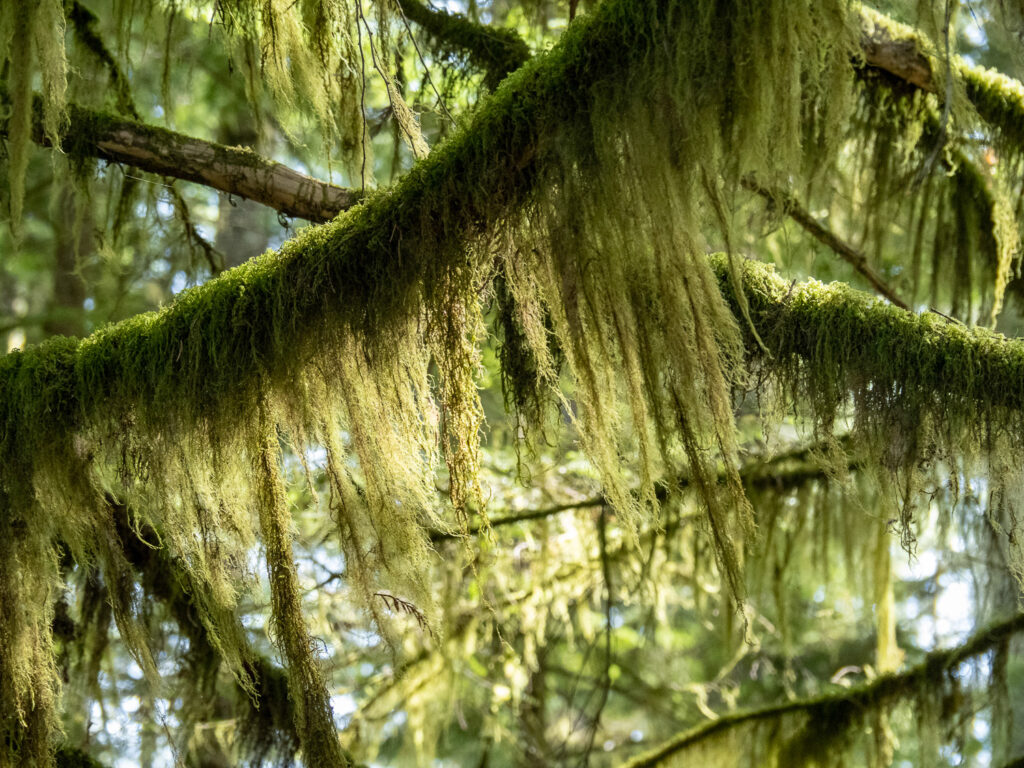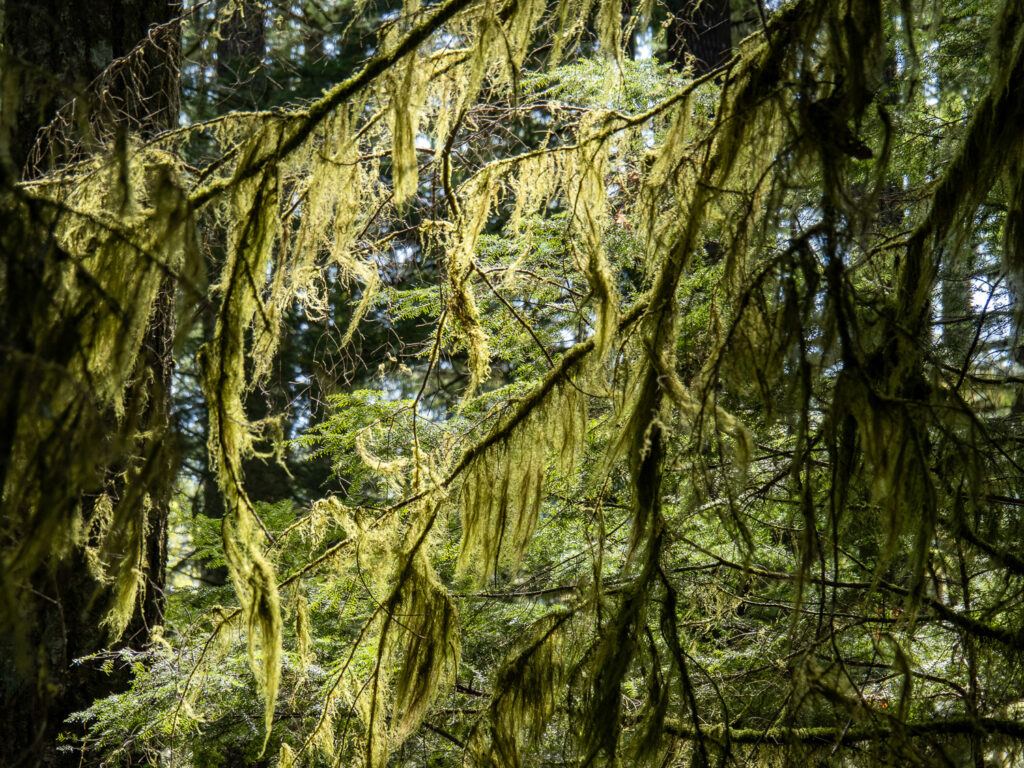Cryptogams
Several studies have found that the abundance and diversity of cryptogamsCryptogams are plants that have no true flowers or seeds and reproduce by spores. They include mosses, liverworts, and lichens. Ferns are considered advanced cryptogams because they reproduce by spores but are differentiated into roots, stems and leaves. Read more about cryptograms. More (including those on the ground or logs, on boles, and epiphytics) generally increases with stand age (e.g., Lesica et al., 1991Lesica, P., McCune, B, Cooper, S.V., Hong, W.S. 1991. Differences in lichen and bryophyte communities between old-growth and managed second growth forests in the Swan Valley, Montana. Can. J. Bot. 69(8):1745-1755. More; Esseen et al., 1996Esseen, P.A., Renhorn, K.E., Pettersson, R.B. 1996. Epiphytic lichen biomass in managed and old-growth boreal forests: effect of branch quality. Ecol. Appl. 6:228-238. More; McCune, 1993McCune, B. 1993. Gradients in epiphyte biomass in three Pseudotsuga-Tsuga forests of different ages in western Oregon and Washington. Bryologist. Omaha, Neb.: American Bryological and Lichenological Society. Fall 1993 96:405-411. More; Stout, 2001Stout, T. 2001. Cryptogams of the Cedar River watershed. More).
In the Cedar Creek watershed in the Pacific Northwest, species richness of cryptogamsCryptogams are plants that have no true flowers or seeds and reproduce by spores. They include mosses, liverworts, and lichens. Ferns are considered advanced cryptogams because they reproduce by spores but are differentiated into roots, stems and leaves. Read more about cryptograms. More increased from early-seral (6 species), to mid-seral (17 species), to late successional/old-growth (29 species) (Stout, 2001Stout, T. 2001. Cryptogams of the Cedar River watershed. More). Lesica et al. (1991)Lesica, P., McCune, B, Cooper, S.V., Hong, W.S. 1991. Differences in lichen and bryophyte communities between old-growth and managed second growth forests in the Swan Valley, Montana. Can. J. Bot. 69(8):1745-1755. More found that leafy lichens were mainly restricted to old growth forests and absent from second growth and nitrogen-fixing foliose lichens were more common in old growth than second growth.
Epiphytic lichens are abundant in old forests, having a biomass sometimes exceeding 1000 kg ha-1 – which is much higher than that in even-aged young forests (Berryman and McCune, 2006Berryman, S., McCune, B. 2006. Estimating epiphytic macrolichen biomass from topography, stand structure and lichen community data. J. Veg. Sci.17:157-170. More). In the coastal western hemlock forests of Clayoquot and Barkley Sounds, epiphytic lichenLichens are complex organisms that arise from the symbiotic relationship between fungi and a photosynthetic partner, typically algae. There are three main types of lichens: foliose, fruticose, and crustose. Foliose lichens are a horizontally growing leafy type of lichen that is always attached to the surface where it is growing. A fruticose lichen is characterized by a coral -like shrubby or bushy growth structure, with upright (pendulous) branches. A crustoselichen is more like a flat crust on a surface or beneath the rock surface or trees. More abundance generally increased with stand age, at least up to 120 years (Price and Hochachka, 2001Price, K., Hochachka, G. 2001. Epiphytic lichen abundance: effects of stand age and composition in coastal British Columbia. Ecol. Appl. 11(3):904-913. More). Young forests (<70 years old) contained no lichenLichens are complex organisms that arise from the symbiotic relationship between fungi and a photosynthetic partner, typically algae. There are three main types of lichens: foliose, fruticose, and crustose. Foliose lichens are a horizontally growing leafy type of lichen that is always attached to the surface where it is growing. A fruticose lichen is characterized by a coral -like shrubby or bushy growth structure, with upright (pendulous) branches. A crustoselichen is more like a flat crust on a surface or beneath the rock surface or trees. More litterfall while young-mature (70–120 years old) cedar and spruce stands contained less lichenLichens are complex organisms that arise from the symbiotic relationship between fungi and a photosynthetic partner, typically algae. There are three main types of lichens: foliose, fruticose, and crustose. Foliose lichens are a horizontally growing leafy type of lichen that is always attached to the surface where it is growing. A fruticose lichen is characterized by a coral -like shrubby or bushy growth structure, with upright (pendulous) branches. A crustoselichen is more like a flat crust on a surface or beneath the rock surface or trees. More than did paired old-growth stands (>300 years old).



In a chronosequence studyA chronosequence study in forest sciences is a study that takes place on a set of forested sites that share similar attributes (e.g., climate and topography) but are of different ages More in the CWHvmCWHvm is the abbreviation for the very wet maritime Coastal Western Hemlock biogeoclimatic subzone. The province of British Columbia is divided into 16 zones, including the Coastal Western Hemlock (CWH). A zone is a large geographic area with a relatively uniform regional climate. The CWH zone is subdivided into climatically distinct subzones, including the vm, or very wet maritime subzone. The CWHvm has a wet, humid, mild, oceanic climate and has an extensive distribution on the BC coast including western Vancouver Island. More subzone on western Vancouver Island, epiphytic lichens dispersed into regenerating stands, but lichenLichens are complex organisms that arise from the symbiotic relationship between fungi and a photosynthetic partner, typically algae. There are three main types of lichens: foliose, fruticose, and crustose. Foliose lichens are a horizontally growing leafy type of lichen that is always attached to the surface where it is growing. A fruticose lichen is characterized by a coral -like shrubby or bushy growth structure, with upright (pendulous) branches. A crustoselichen is more like a flat crust on a surface or beneath the rock surface or trees. More colonies there were insignificant in comparison to those in older forests in terms of abundance and diversity (Enns et al., 1999Enns, K.A., Trofymow, J.A., Goodman, D. 1999. Arboreal lichens in successional forests on southern Vancouver Island. Natural Resources Canada, Canadian Forest Service, Pacific Forestry Centre, Victoria, BC. Information Report BC-X-382. 22 p. More). There was an average of about 6 epiphytic lichenLichens are complex organisms that arise from the symbiotic relationship between fungi and a photosynthetic partner, typically algae. There are three main types of lichens: foliose, fruticose, and crustose. Foliose lichens are a horizontally growing leafy type of lichen that is always attached to the surface where it is growing. A fruticose lichen is characterized by a coral -like shrubby or bushy growth structure, with upright (pendulous) branches. A crustoselichen is more like a flat crust on a surface or beneath the rock surface or trees. More species per branch in old growth, compared to 3 species in mature, 2 species in immature and 1 species in regenerating stands. A total of 18 species were found in old growth compared to 14 in mature stands, 13 in immature and 8 in regenerating stands. Some arboreal lichenLichens are complex organisms that arise from the symbiotic relationship between fungi and a photosynthetic partner, typically algae. There are three main types of lichens: foliose, fruticose, and crustose. Foliose lichens are a horizontally growing leafy type of lichen that is always attached to the surface where it is growing. A fruticose lichen is characterized by a coral -like shrubby or bushy growth structure, with upright (pendulous) branches. A crustoselichen is more like a flat crust on a surface or beneath the rock surface or trees. More species were restricted to mature and old growth forests and Cladonia spp. were most abundant in the older stands. A few species were restricted to second growth or immature stands and some species occurred in stands of all ages. Regenerating and immature stands were characterized by species which disperse and colonize rapidly and tolerate extreme conditions, including the fruticose pendulous lichens such as Usnea and Alectoria. Mature and old growth forests had more of the easily fragmented foliose lichens such as Platismatia glauca and species of Hypogymnia.
